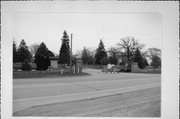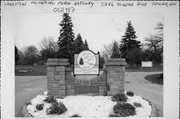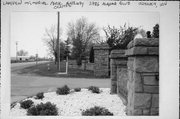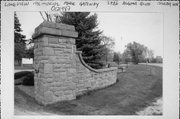| Additional Information: | April 2001-Lake View Memorial Park was established in 1931. The layout is curvilinear. The principal road winds east from STH 110 (Algoma Boulevard). This cemetery features a Rustic style Gateway (WN-132/1) and a lovely, Neo-Gothic Revival Chapel (WN-131/23). The flat, ground-level markers intensify the park-like appearance of the Lake View Memorial Park. A very large, c. 1970 public mausoleum with dozens of crypts is located at the south of the cemetery known as the memorial park."
Lake View Memorial Park Gateway
The Gateway dates from c. 1931 and consists of three elements, all Rustic in style and constructed of beige, rock-faced, random ashlar. In the center, two, square, stone posts bolster a stone wall, the top of which is convex. A bronze plaque is attached to the front (west) face of the wall and reads: LAKE VIEW MEMORIAL PARK. The road into the cemetery divides around this center wall, separating the center wall from the flanking north and south wall. The north and south walls are similar to one another. A tall, stone post anchors that end of each wall standing closest to the entrance. A stone wall, its top curving down, arcs to a small stone post. A metal bracket on each of the posts that stand on either side of the entrance shows that metal gates once hung from the Gateway. The Gateway is a good example of a Rustic style gateway, but is a small resource and is not sufficiently developed architecturally to qualify individually for the National Register of Historic Places under Criterion C.
Statement of Significance: Lake View Memorial Park and its curvilinear plan, the Gateway and the Chapel, were evaluated under Criterion C as a type of twentieth century rural cemetery called the "memorial park," a designed landscape. While the "rural" cemetery with its park-like appearance developed in the nineteenth century, it evolved over time. From the 1830s and into the 1920s, the ideal rural cemetery possessed a curvilinear plan (in imitation of nature); a chapel; a gateway; a wide variety of monuments, markers and mausoleums; and an abundance of trees and shrubs, often planted by the living in memory of their dead. After World War I, the elaborate monuments and mausoleums began to fall out of favor, and were seen as ostentatious and even vulgar. At the same time, the gas-powered lawn mower became widely available. These occurrences combined to alter the ideal appearance of a rural cemetery. The new rural cemetery incorporated a curvilinear plan, a chapel and a gateway, but the markers were placed at ground level and plantings limited, increasing the park-like appearance and making mowing easier. This new type of rural cemetery was called the "memorial park," and a new cemetery designed with this image in mind often included "memorial park" in its name. Memorial parks have been widely built since the 1920s and are quite common. |
|---|




